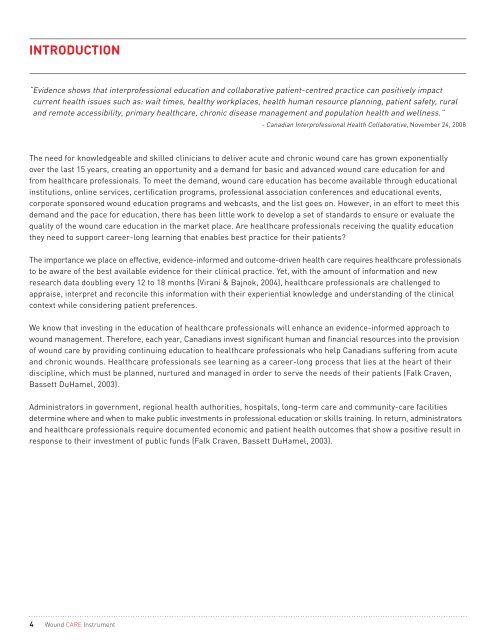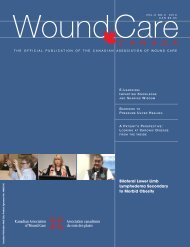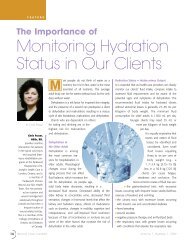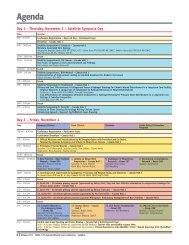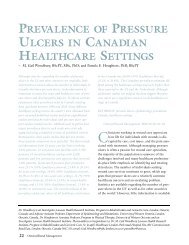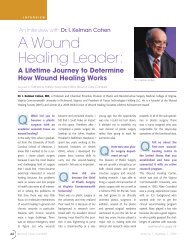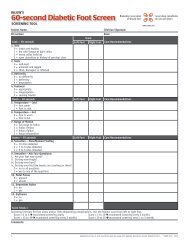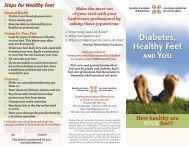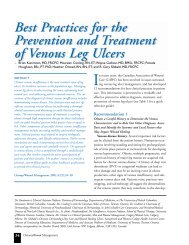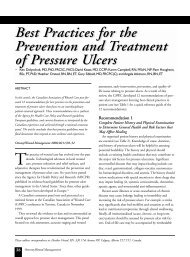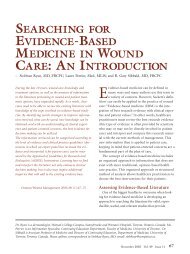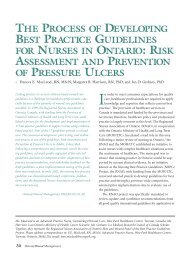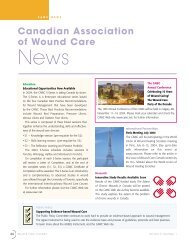Wound Care Instrument - Canadian Association of Wound Care
Wound Care Instrument - Canadian Association of Wound Care
Wound Care Instrument - Canadian Association of Wound Care
You also want an ePaper? Increase the reach of your titles
YUMPU automatically turns print PDFs into web optimized ePapers that Google loves.
iNtroDUCtioN<br />
“ Evidence shows that interpr<strong>of</strong>essional education and collaborative patient-centred practice can positively impact<br />
current health issues such as: wait times, healthy workplaces, health human resource planning, patient safety, rural<br />
and remote accessibility, primary healthcare, chronic disease management and population health and wellness.”<br />
4 <strong>Wound</strong> CARE <strong>Instrument</strong><br />
- <strong>Canadian</strong> Interpr<strong>of</strong>essional Health Collaborative, November 24, 2008<br />
The need for knowledgeable and skilled clinicians to deliver acute and chronic wound care has grown exponentially<br />
over the last 15 years, creating an opportunity and a demand for basic and advanced wound care education for and<br />
from healthcare pr<strong>of</strong>essionals. To meet the demand, wound care education has become available through educational<br />
institutions, online services, certification programs, pr<strong>of</strong>essional association conferences and educational events,<br />
corporate sponsored wound education programs and webcasts, and the list goes on. However, in an effort to meet this<br />
demand and the pace for education, there has been little work to develop a set <strong>of</strong> standards to ensure or evaluate the<br />
quality <strong>of</strong> the wound care education in the market place. Are healthcare pr<strong>of</strong>essionals receiving the quality education<br />
they need to support career-long learning that enables best practice for their patients?<br />
The importance we place on effective, evidence-informed and outcome-driven health care requires healthcare pr<strong>of</strong>essionals<br />
to be aware <strong>of</strong> the best available evidence for their clinical practice. Yet, with the amount <strong>of</strong> information and new<br />
research data doubling every 12 to 18 months (Virani & Bajnok, 2004), healthcare pr<strong>of</strong>essionals are challenged to<br />
appraise, interpret and reconcile this information with their experiential knowledge and understanding <strong>of</strong> the clinical<br />
context while considering patient preferences.<br />
We know that investing in the education <strong>of</strong> healthcare pr<strong>of</strong>essionals will enhance an evidence-informed approach to<br />
wound management. Therefore, each year, <strong>Canadian</strong>s invest significant human and financial resources into the provision<br />
<strong>of</strong> wound care by providing continuing education to healthcare pr<strong>of</strong>essionals who help <strong>Canadian</strong>s suffering from acute<br />
and chronic wounds. Healthcare pr<strong>of</strong>essionals see learning as a career-long process that lies at the heart <strong>of</strong> their<br />
discipline, which must be planned, nurtured and managed in order to serve the needs <strong>of</strong> their patients (Falk Craven,<br />
Bassett DuHamel, 2003).<br />
Administrators in government, regional health authorities, hospitals, long-term care and community-care facilities<br />
determine where and when to make public investments in pr<strong>of</strong>essional education or skills training. In return, administrators<br />
and healthcare pr<strong>of</strong>essionals require documented economic and patient health outcomes that show a positive result in<br />
response to their investment <strong>of</strong> public funds (Falk Craven, Bassett DuHamel, 2003).


